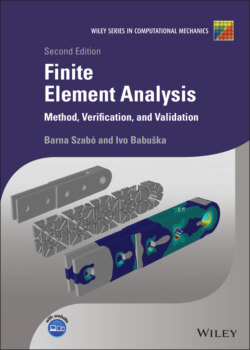Читать книгу Finite Element Analysis - Barna Szabó - Страница 46
1.5.4 Error in the extracted QoI
ОглавлениеIn Example 1.9 it was demonstrated that the QoI can be extracted from the finite element solution efficiently and accurately even when the discretization was very poorly chosen. Let us consider a quantity of interest and the corresponding extraction function . The extracted value of the QoI is
(1.109)
Figure 1.9 Relative error in energy norm. , .
Figure 1.10 Relative error in energy norm. , .
and the exact value of the QoI is
(1.110)
Subtracting eq. (1.109) from eq. (1.110) we get
(1.111)
We define a function such that
(1.112)
This operation projects onto the space . Letting we get:
We will write this as
(1.113)
Next we define such that
(1.114)
This operation projects onto the space . By Galerkin's orthogonality condition (see Theorem 1.3) we have
Therefore, letting , we write eq. (1.113) as
(1.115)
and we can write eq. (1.111) as
(1.116)
Therefore the error in the extracted data is
(1.117)
where we used the Schwarz inequality, see Section A.3 in the appendix.
The function made it possible to write the error in the QoI in this form. It does not have to be computed.
Inequality (1.117) serves to explain why the error in the extracted data can converge to zero faster than the error in energy norm: If is of comparable magnitude to then the error in the extracted data is of comparable magnitude to the error in the strain energy, that is, the error in energy norm squared. But, as seen in Example 1.9, where w was much smoother than , it can be much smaller. In the exceptional case when the extraction function is Green's function, the error is zero.
